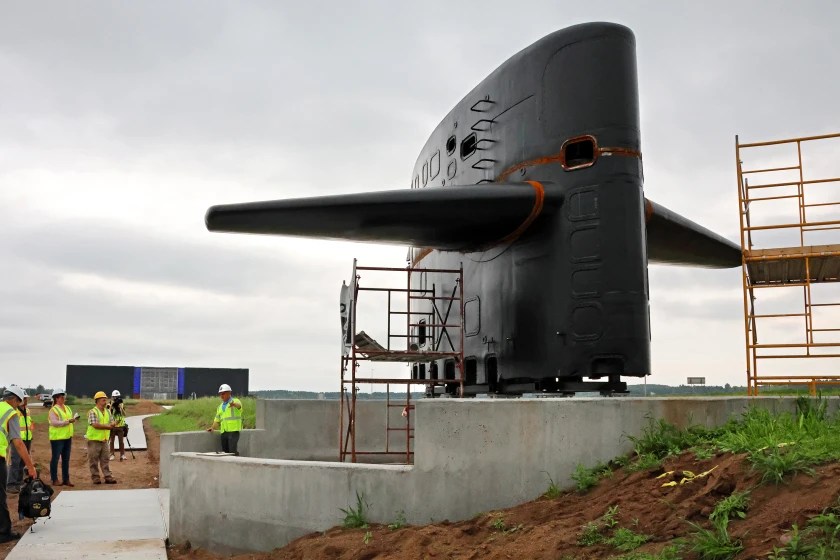CAMP RIPLEY — Taking shape and nearing the halfway point of completion, the Minnesota Military and Veterans Museum welcomed stakeholders to view its progress outside of Camp Ripley in central Minnesota.
On Wednesday, July 23, the museum gave three tours to around 50 key supporters and members of the media, who were given the opportunity to walk through the construction site, view the museum and hear about the plans for its space.
The Minnesota Military and Veterans Museum at Camp Ripley officially began construction north of Little Falls, Minnesota, on Aug. 1, 2024, following a ceremonial groundbreaking in September 2023. The facility and surrounding grounds are set for completion and grand opening in the summer of 2026 as the United States celebrates its 250th anniversary.
Randal Dietrich, executive director of the Minnesota Military and Veterans Museum, said the space had changed drastically over the last few years, noting the field used to be filled with sunflowers when they broke ground in 2023.
“What used to be a 32-acre sunflower field, donated to us by a local resident, has been a real game-changer for the museum, especially in terms of highway exposure and accessibility to our new museum,” Dietrich said. “Our current museum remains open to support veterans and their families and the general public. But concurrent with that, we’re also finishing up construction.”
He said the new museum will provide easy access to its space, as those who visit the current museum need to pass through a security checkpoint on Camp Ripley, since the museum is located inside its gates.
“Not going through the gate anymore, but simply pulling off the highway using the off ramp and being here in the midst of a lot of military history,” Dietrich said. “So a dramatic change for us to have much more space and much greater accessibility and visibility for what we’re doing.”
The museum will feature numerous macro artifacts, Dietrich said, as he pointed out the conning tower — or raised platform — of the decommissioned USS Minneapolis-Saint Paul, which will be part of an outdoor exhibit visible from the highway.
The museum website states the USS Minneapolis-Saint Paul was a nuclear-powered Los Angeles-class submarine in service between 1984 and 2008. Known with the hull classification of SSN-708, the submarine served with distinction in Operation Desert Shield and the First Gulf War. It was the first submarine to carry Tomahawk missiles specifically designated for use in strikes against Iraq.
The rudder and conning tower are surrounded by a 360-foot silhouette of the submarine rising out of the Minnesota prairie.
“Visitors will get a sense of that, the full length of that submarine, 360 feet, of what that submarine was,” Dietrich said. “Then, in coming to the museum, you’ll get to hear stories of Minnesotans who served on board that very submarine, and what that was like.”
The group was then led across the parade grounds on the south end of the building before entering the museum through what will eventually be its entrance.
As Minnesotans have served with distinction since the Civil War, Dietrich said the new museum will give them the opportunity to showcase Minnesota service through the years.
“The chance to move from a 5,000 square foot gallery space to a 40,000 square foot building is a game-changer,” Dietrich said.
Walking in through what would eventually become the front entrance, Dietrich pointed out that some of the offices at Camp Ripley would be moving over to the new museum building, such as a new ID card center and some environmental stewardship offices.
With metal studs taking shape to outline what will eventually be the different sections of the museum, Dietrich said they would have a Huey helicopter in their Vietnam exhibit to showcase what veterans dealt with in Vietnam.
“We’re working to tell their stories,” Dietrich said.
Dietrich said they had finished working on interviewing Paul Nakasone, a retired four-star general. He said Nakasone’s father had been having breakfast with his family on Pearl Harbor the morning of Dec. 7, 1941, and Paul Nakasone had been at the Pentagon the morning of Sep. 11, 2001.
“Telling those stories is really important to us,” Dietrich said. “That’s work’s worth doing, and that’s what we’re really about.”
Though it was just an empty space he was pointing to in the building, Dietrich said the area would have large glass windows to allow the public to observe the artifacts through a large window in their archive area.
There will be a private library space, suited for conversations with donors and family members who wish to view a family heirloom in private.
Day by day, the museum continues to take shape and as they grow closer to finishing the 40,000 square foot building, they will begin moving in exhibits that have yet to be seen by the public, as their current building limits all they can do and show.
The museum is planning to open in the summer of 2026. More information about the Minnesota Military and Veterans Museum can be found at mnvetmuseum.org.
Related Articles
Toxic blue-green algal blooms are fouling Minnesota waters this summer
Large portion of MN (including metro) is under red air quality alert until Saturday due to wildfires
DWI reform, service dogs: New laws take effect Aug. 1 in Minnesota
Minnesota Historical Society to lay off 36, reduce services
State forecasts loss of $1.4B in Medicaid funding; 140K will lose coverage


Leave a Reply